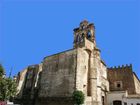
The artistic patrimony of Beturia is as wide and varied as its historic legacy.
The Señorío de Feria. Templar LandsPart of the physiognomy of Zafra-Río Bodión are the rock castles that crown the most outstanding summits of its topography. Possibly there is not such a concentration of first order fortresses in any other region of Extremadura with 4 villages declared Historic-Artistic Complex: Zafra (3) and Feria (1) linked to the Dukedom of Feria, Burguillos del Cerro (4) linked to the Order of Knight Templar and Fuente del Maestre (2) linked to the Order of Santiago. On the historic side, this land is the origin of the Dukedom of Feria, with the donation given in 1394 by Enrique the III of Castile to Gómez Suárez of Figueroa. Two centers are mainly responsible of the memory of the Suárez of Figueroa. One is Zafra, beautiful town, stately and courtesan, from which we must highlight the Palace of the Dukes of Feria, the Monastery of Santa Clara, the Hospital of Santiago and the Collegiate Church of the Candelaria. The other is Feria, strategic and warrior focus. The Tierra de Barros was populated since the Roman period, as it is demonstrated by the numerous testimonies of the prehistoric periods, Preroman and Roman. Nevertheless, it reaches its highest flowering and significance after the Christian conquest in the XIII Century, period in which the territory was divided between the jurisdictions of the Order of Santiago and the Domain of Feria, so historically was distributed between two of the most powerful demarcations of Extremadura. Castles and FortressesIn Tentudía was the medieval period the one that left a biggest trace in the zone. Its frontier situation between the Arab and Christian Kingdoms during a large period can be seen in the military constructions, among which we must highlight the Almohade castle of Montemolín (9) and a medieval castle in Segura de León (6), which dates of the XV Century. This last one, residence of the Commanders of Santiago, has become nowadays a splendid and comfortable accommodation for tourists, where stands out its impressive defensive fence and the tower of the tribute. But it is, without a doubt, the religious patrimony the one that has more presence in the region, highlighting, among the numerous convents, chapels and stone crosses, the Monastery of Santa María of Tentudía (XV and XVI Centuries) (8) and the Conventual Santiago in Calera de León (7), both protected monuments. Also the frontier nature of the region Sierra Suroeste become a reality above all in the fortifications and walls used to safeguard populations, from which we keep great beautiful samples. There are many constructions with Mudejar, Gothic, Renaissance and Baroque influences. Jerez de los Caballeros(5), Historic and Artistic Complex, is a strategic enclave solidly fortified, of Roman, Visigoth and Arab precedents. Its maximal apogee arrived in the XIII Century, when it was the capital of Bailato del Temple, preserving from that past magnificence a spectacular templar fortress. The town has also some of the most beautiful Baroque constructions of Extremadura, expressed in its four emblematic churches. The Templar influence extended to Frenegal de la Sierra and Higuera la Real. Mudejar AestheticsThe visitor of the Campiña Sur will enjoy a wide monumental and artistic range that dates from prehistory, with important megalithic remains in the area of Azuaga (12); it passes by the Romans (Roman Theater of Regina) (10); the medieval period (Alcazaba de Reina) and until the contemporary period with the magnificent stately houses of the XVIII and XIX Centuries distributed all along the region. But it will be the Mudejar aesthetic the one that brights the most, including the Campiña Sur one of the most important Mudejar complexes of the Baja Extremadura. Its influences are to be seen in religious and popular constructions, as in the towns of Llerena (CHA) (11) and Azuaga.
|

